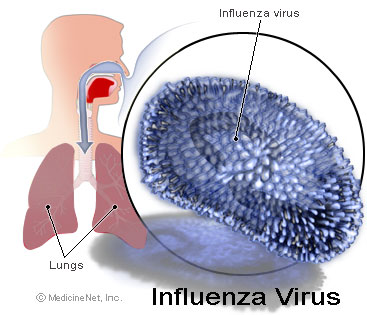Influenza Virus
Influenza is more commonly known as the flu. It is caused by influenza viruses, and can range from a mild virus to severe, and sometimes leading to death. The influenza virus is a very common occurrence in not only the United States, but all around the world. This virus is so common, that each year 5%-20% of the nation will get it at some time. Not all forms are as severe as others, but many of these outbreaks will send hundreds of thousands of people to hospitals around the country. Tens of thousands of people die each year from the outbreak as well. When people die from the influenza virus, they are typically young children, elderly, or people with weak immune systems.
As far as symptoms go, there is a very large variety of symptoms. You may have all of these symptoms, or you may only have a couple. The most common symptoms of the influenza virus are high fever, tiredness, and a headache. Some other symptoms include, but are not limited to, dry cough, sore throat, runny or stuffy nose, and muscle aches. Stomach symptoms such as nausea, diarrhea, and vomiting can occur, but are usually more common in young children compared to adults. Having the flu can cause other complications as well. Ear infections, dehydration, pneumonia, sinus infections, and worsening of other chronic medical conditions can be complications of the influenza virus.
Influenza is spread by coughing and sneezing, or touching something with the virus on it, and then touching your nose or mouth. Something that many people do not know is that you can get the flu from somebody a day before they even start to show symptoms. This virus continues to be contagious up to 5 days after the symptoms occur.
 |  Structure of the Influenza virus (top) Image of the Influenza virus (left) |
Treatment and Prevention
 | In order to stay away from the flu, getting a vaccination each year is a very good step to take. Somebody can get either the flu shot, or the flu nasal spray. But create antibodies or kill the virus. In order to treat the flu, there are some antiviral drugs that can be taken, but also most of the time you just have to let the virus run its course. There are some medications for the symptoms of the flu, but nothing that will completely get rid of it. |
The Effect of Global Warming on Influenza
Influenza viruses can be found in glaciers around the world that are melting. These viruses are known to have been dormant for decades and possibly even centuries. When birds fly over the glaciers, their droppings fall on the glaciers and get frozen into the glacier. These viruses haven’t been existent in a very long time, and can cause a lot of damage. Researchers think that these viruses can survive a long time in ice, but are not sure how many of the viruses are still alive. The avian flu is also going to increase with global warming. With higher temperatures, the bacteria can thrive on this, creating more possibly of the disease to spread. During the time of the last outbreak, was also a time when the weather was becoming warmer. Because of growing temperatures, animals and pests can change where they typically live. They will be able to live in broader ranges than they have before. Germs that used to be in the tropics will expand and grow further north. People that are not immune to diseases will be able to catch them a lot easier.
Sources for Influenza Page:
http://www.cdc.gov/flu/keyfacts.htm
http://news.softpedia.com/news/New-Deadly-Flu-Viruses-Reemerge-From-Melting-Ice-41587.shtml
http://www.usatoday.com/weather/climate/globalwarming/2007-05-22-climate-change_N.htm
http://www.cdc.gov/flu/keyfacts.htm
http://www.medicinenet.com/influenza/article.htm
http://medicineworld.org/news/news-archives/infectious-disease-news/390174955-Nov-18-2006.html
http://www.stjohns.edu/academics/graduate/pharmacy/symposiums/influenza_2006